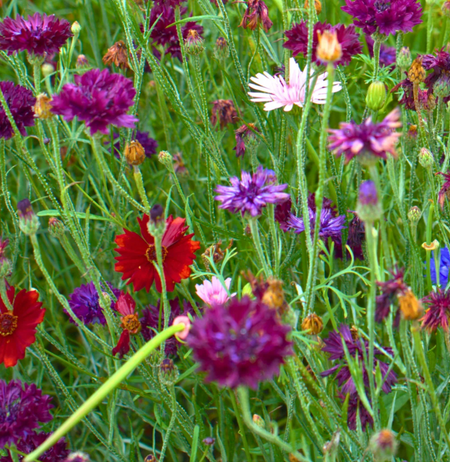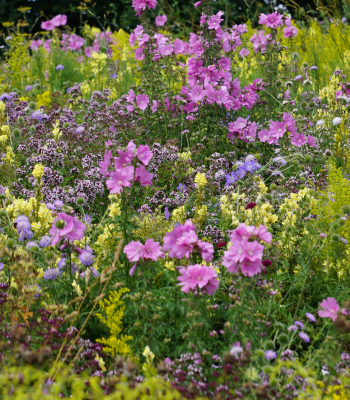Sowing Times and Conditions
When
Sow in the spring between March, April, May, or early June at the latest. Wait for signs that the soil is warming up, such as weed and wildflower seedlings appearing on bare earth. April is usually the best month to prepare the ground and sow the seeds. In mild areas, autumn sowing is possible for an early flowering display but will result in the loss of some (or all) of the display if there is frosty weather during the winter or spring.
Where
Any open, sunny location which gets at least a couple of hours of sunshine each day. For the best results, choose the sunniest spot. A shady position will result in patchy growth and poor flowering. Sow into any free-draining soil or compost. They can be sown in pots, window boxes, containers, tubs or raised beds.
Ground Preparation
Weeds
It is important to sow onto a very clean seed bed and ensure that all visible weeds, especially grass, are removed. Ideally, this includes killing or removing the roots and rhizomes of perennial weeds. Do not sow into existing grass or other vegetation as this will lead to failure. If you think the area has a lot of weed seeds present in the soil, you can spread a 5-10cm deep sowing mulch of weed-free compost or soil improver over the area to create a clean surface to sow onto.
Soil Preparation
Once weeds have been removed, cultivate the ground shallowly by using a rake to form a nice level seedbed that has a fine, crumbly texture. If the soil is hard and compacted, shallowly cultivate the area by turning the soil with a fork or cultivating with a rotavator. Cultivate the soil to around 7cm (3 inches) and then rake to form a crumb texture seed bed.
Sowing Your Seed
Sowing Rate
Our annuals should be sown at a rate of 3g per square metre.
How to Sow
Mix your seed thoroughly with an inert bulking material such as sawdust, coir or even builders sand at a rate of five-parts-sand to one-part-seeds to help distribute the seed over the area. This will also allow you to see where the seed has been sown. Sow the seed/sand mix evenly over the whole area by scattering in different directions, ensuring that you keep the mix well mixed throughout the sowing process. We always recommend sowing by hand as this gives the best results.
Rolling and Watering
The seed/carrier mix is sown onto the surface, and it is essential that it is firmed onto the soil surface by using a garden roller, back of a spade or even walking over it. Normally, annual seeds will not require any form of watering in the UK, but if drought conditions are experienced, then watering will be required. Watering is best done by leaving a sprinkler on the area in the early morning/late evening and letting the ground become completely saturated so the water soaks down into the soil where it won’t evaporate and encourages deep root growth. Giving a lot of water every few days is much better than giving a little water every day. Stop once the ground is covered with seedlings.
Establishment and Management
Growth
You could expect to see the first signs of germination in 7-10 days. Growth can be very rapid after this, and flowers may start appearing as early as 6 weeks after sowing.
Weeding
If ground preparation has been good, then it is normal not to undertake any form of maintenance such as weeding at all throughout the whole of the flowering season. Our annuals are specifically designed to throw up taller and taller flowering stems as the year progresses and this characteristic, along with the very high flower content, is effective at ‘masking’ weeds that do invade. If there are a lot of weeds, they can be hand-pulled as soon as they are identified while trying to keep meadow trampling to a minimum. The earlier you do this, the better.
End of Season
Once the flowering season has finished, the area can be cut down and left on the surface as mulch or removed and composted. This can happen any time from autumn through to late winter. Leaving the meadow standing over winter provides oil-rich seeds for birds and hollow stems for overwintering insects. Standing seedheads can look attractive too. There may be some re-seeding of certain species the following spring, which can give a limited flowering display. However, to get a full pictorial display, you should freshly prepare the area again by re-cultivating the ground and re-sowing the following spring.
Frequently Asked Questions
Are annual meadows easy to grow, especially if I have little gardening experience?
Yes, annual meadows are easy to grow and are a great way for less confident gardeners to start with.
When is the best time to sow annual seeds?
The best month is April, but you can sow early in March if the ground feels workable and as late as early June.
Can I sow an annual meadow in the autumn?
Yes, but it is not advised if this is going to be your main display. Not all the annual seeds will survive in the ground over our cold and wet winters. However, some viable seeds of some species will survive and provide an earlier if different display.
Can I mix the annual seed with perennial seed?
No. If you are trying to establish a proper perennial meadow then do not put annual seeds with the mix. Annuals in the wrong amounts will very quickly out-compete the slower growing perennials and prevent many of them from establishing successfully.
Can I mix the annual seed with grass to make it go further?
No. Grass is very competitive and will quickly dominate the annual meadow plants and reduce the impact of the flowers.
What happens if I sow less or more than the recommended rate?
It’s best to stick to the 3g per square metre rule for annuals as that’s how we’ve formulated the meadow designs. 3 grams gives a good display on most soil types. Increasing the sowing rate will often mean more interspecies competition, which results in less diverse meadows dominated by just a few species. Decreasing the rate, especially below 2g, will make the meadow look very sparse to start with and encourage more weed invasion.
If I’ve sown an annual meadow one year, will it regrow the next year?
No, not really. Many species won’t reseed at all. Some species will, but in a much more random and patchy way. However, if you have fairly infertile soil or you have experienced very little weed infestation, you can get some lovely second and third-year displays taking place from the few species that do reseed.
Do I need to protect the seed from birds, mice, or squirrels?
Only very rarely. We have sown hundreds of meadows in areas that have never shown any predation by birds or other animals, but that doesn’t mean it can’t ever happen.
What effect will the fertility of my soil have on the display?
Annual meadows thrive on normal to high fertility soils, making them the perfect meadow solution for most gardens and parks. The richer the soil though, the taller and bushier the plants will be. The thinner and poorer the soil, the opposite will happen. Normally, if you grow annual meadows on the same patch of ground for more than three years, you will see the fertility start to decrease and the emerging meadows look finer and shorter. This is a perfect time to think about moving onto establishing a perennial meadow, which does best on lower fertility soils.
My display has been looking great, but in the recent hot and dry weather it is starting to go over. Is there anything I can do?
Most years, the displays carry on with later, taller flowers masking the shorter, earlier ones. Sometimes it’s just a question of giving nature a little bit more time. Even if the later flowers are less showy, they will still have a lot of sparkle. If they’re looking more brown than colourful, you can give them the ‘Chelsea chop,’ which is a very high cut to knock off the seeding flower heads and stimulate a second flush of greener growth and flowers.
It looks like I just have a blanket of weeds, is there anything I can do?
Unfortunately this sometimes happens if there is a big weed seed bank in your soil, but don’t panic. Wait until your weeds are about 150mm (6 inches) tall and run your mower over the whole area on the highest cut. This checks the weeds and allows the slower growing meadow seedlings to come through.
Do I need to irrigate my annual meadow?
No, but it’s important to roll or firm the seeds into the ground so the seedlings get enough moisture. The seeds will germinate readily as soon as the soil is warm and moist enough. The only time an annual meadow might need irrigation is if it must be in flower for a particular date and the weather has turned exceptionally dry and hot. In these circumstances, a couple of good soakings will help things along, but stop as soon as seedlings have created a green cover over the soil.
Does the sowing time impact the length of the flowering time?
Every year is different. In general, early sowings will mean your meadow will come into flower earlier. If the summer is very hot and dry, they may finish earlier.
How early and how late can I safely sow annual seeds?
The best month is April, but you can sow early in March if the ground feels workable and as late as early June.
Can I sow my seeds over existing grass?
No, grass will prevent your seeds from growing. You need to prepare a very clean, weed-free seed bed.
Are there any grasses in your annual mixes?
No, we don’t add any grasses to our annual mixes.
What do I need to do if I want to resow with an annual mix for a second or follow-on year?
You must start from scratch each spring by cutting down any old growth and creating a clean, cultivated seed bed again. You will find that both weeds and a few self-seeded annuals will start to build up in the seed bed over time.
Which mix is best for clay soil?
All our annual mixes will grow well on clay soils.
Do I need to worry about slugs and snails eating my annual meadow seedlings?
Very occasionally, slugs have been known to graze young, emerging annual meadow sowings.
Do you ship worldwide?
No, but you can purchase the Pictorial Meadows seed mixes through our European agents Florum DK and Bloomingfields.





